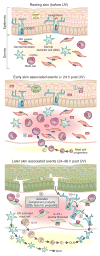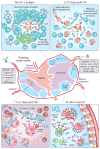The immunologic revolution: photoimmunology
- PMID: 22170491
- PMCID: PMC3279601
- DOI: 10.1038/jid.2011.405
The immunologic revolution: photoimmunology
Abstract
UV radiation targets the skin and is a primary cause of skin cancer (both melanoma and nonmelanoma skin cancer). Exposure to UV radiation also suppresses the immune response, and UV-induced immune suppression is a major risk factor for skin cancer induction. The efforts of dermatologists and cancer biologists to understand how UV radiation exposure suppresses the immune response and contributes to skin cancer induction led to the development of the subdiscipline we call photoimmunology. Advances in photoimmunology have generally paralleled advances in immunology. However, there are a number of examples in which investigations into the mechanisms underlying UV-induced immune suppression reshaped our understanding of basic immunological concepts. Unconventional immune regulatory roles for Langerhans cells, mast cells, and natural killer T (NKT) cells, as well as the immune-suppressive function of lipid mediators of inflammation and alarmins, are just some examples of how advances in immunodermatology have altered our understanding of basic immunology. In this anniversary issue celebrating 75 years of cutaneous science, we provide examples of how concepts that grew out of efforts by immunologists and dermatologists to understand immune regulation by UV radiation affected immunology in general.
Conflict of interest statement
Figures


Similar articles
-
Photoimmunology.Dermatol Clin. 2014 Jul;32(3):277-90, vii. doi: 10.1016/j.det.2014.03.005. Epub 2014 May 5. Dermatol Clin. 2014. PMID: 24891051 Free PMC article. Review.
-
Reflections on the field of photoimmunology.J Invest Dermatol. 2013 Jan;133(1):27-30. doi: 10.1038/jid.2012.234. Epub 2012 Aug 2. J Invest Dermatol. 2013. PMID: 22854621 Free PMC article. Review.
-
Ultraviolet immunosuppression: mechanisms and consequences.Dermatol Clin. 2006 Jan;24(1):19-25. doi: 10.1016/j.det.2005.08.003. Dermatol Clin. 2006. PMID: 16311164 Review.
-
[Ultraviolet radiation--immune response].J Dtsch Dermatol Ges. 2005 Sep;3 Suppl 2:S11-8. doi: 10.1111/j.1610-0387.2005.04393.x. J Dtsch Dermatol Ges. 2005. PMID: 16117738 Review. German.
-
Photoimmune suppression and photocarcinogenesis.Front Biosci. 2002 Mar 1;7:d684-703. doi: 10.2741/A804. Front Biosci. 2002. PMID: 11861222 Review.
Cited by
-
Effect of ultra violet irradiation on the interplay between Th1 and Th2 lymphocytes.Front Pharmacol. 2015 Mar 24;6:56. doi: 10.3389/fphar.2015.00056. eCollection 2015. Front Pharmacol. 2015. PMID: 25852558 Free PMC article.
-
Platelet-rich plasma regulating the repair of ultraviolet B-induced acute tissue inflammation: adjusting macrophage polarization through the activin receptor-follistatin system.Bioengineered. 2021 Dec;12(1):3125-3136. doi: 10.1080/21655979.2021.1944026. Bioengineered. 2021. PMID: 34193023 Free PMC article.
-
Curcumin-Loaded Liposomes in Gel Protect the Skin of Mice against Oxidative Stress from Photodamage Induced by UV Irradiation.Gels. 2024 Sep 16;10(9):596. doi: 10.3390/gels10090596. Gels. 2024. PMID: 39330198 Free PMC article.
-
UV Radiation Induces the Epidermal Recruitment of Dendritic Cells that Compensate for the Depletion of Langerhans Cells in Human Skin.J Invest Dermatol. 2015 Aug;135(8):2058-2067. doi: 10.1038/jid.2015.118. Epub 2015 Mar 25. J Invest Dermatol. 2015. PMID: 25806853
-
Will Global Climate Change Alter Fundamental Human Immune Reactivity: Implications for Child Health?Children (Basel). 2014 Nov 11;1(3):403-23. doi: 10.3390/children1030403. Children (Basel). 2014. PMID: 27417487 Free PMC article.
References
-
- Alappatt C, Johnson CA, Clay KL, Travers JB. Acute keratinocyte damage stimulates platelet-activating factor production. Arch Dermatol Res. 2000;292:256–9. - PubMed
-
- Alard P, Kurimoto I, Niizeki H, Doherty JM, Streilein JW. Hapten-specific tolerance induced by acute, low-dose ultraviolet B radiation of skin requires mast cell degranulation. Eur J Immunol. 2001;31:1736–46. - PubMed
-
- Alard P, Niizeki H, Hanninen L, Streilein JW. Local ultraviolet B irradiation impairs contact hypersensitivity induction by triggering release of tumor necrosis factor-alpha from mast cells. Involvement of mast cells and Langerhans cells in susceptibility to ultraviolet B. J Invest Dermatol. 1999;113:983–90. - PubMed
-
- Alves-Filho JC, Sonego F, Souto FO, Freitas A, Verri WA, Jr, Auxiliadora-Martins M, et al. Interleukin-33 attenuates sepsis by enhancing neutrophil influx to the site of infection. Nat Med. 2010;16:708–12. - PubMed
-
- Anglin JH, Jr, Bever AT, Everett MA, Lamb JH. Ultraviolet-light-induced alterations in urocanic acid in vivo. Biochim Biophys Acta. 1961;53:408–9. - PubMed
Publication types
MeSH terms
Grants and funding
LinkOut - more resources
Full Text Sources
Medical
Miscellaneous

